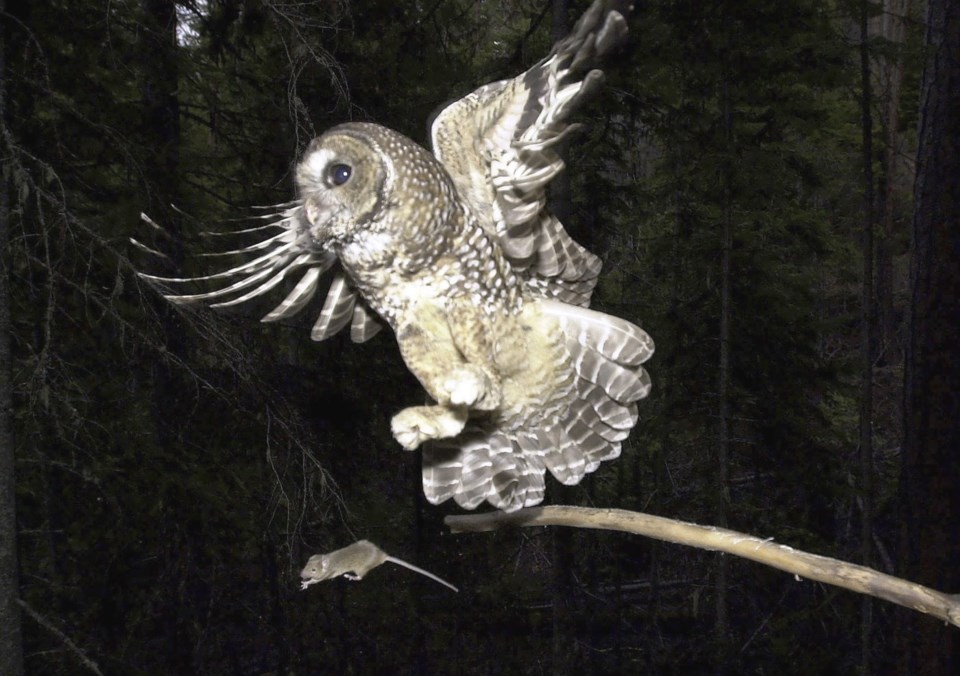U.S. wildlife officials beginning next year will drastically scale up efforts to kill invasive barred owls that are crowding out imperiled native owls from West Coast forests, under a plan finalized Wednesday that faces challenges from barred owls returning after they've already been removed.
Trained shooters will target barred owls over 30 years across a maximum of about 23,000 square miles (60,000 square kilometers) in California, Oregon and Washington. The U.S. Fish and Wildlife Service goal is to kill up to 452,000 barred owls and halt the decline of competing northern spotted owls and California spotted owl s.
Killing one bird species to save others has divided wildlife advocates and is reminiscent of past government efforts to save West Coast salmon by killing sea lions and cormorants, and to preserve warblers by killing cowbirds that lay eggs in warbler nests. The barred owl removals would be among the largest such effort to date involving birds of prey, researchers and wildlife advocates said.
Native to eastern North America, barred owls started appearing in the Pacific Northwest in the 1970s. They've quickly displaced many spotted owls, which are smaller birds that need larger territories. An estimated 100,000 barred owls now live within a range that contains only about 7,100 spotted owls, according to federal officials.
The newcomers' arrival also threatens to decimate frog and salamander species that barred owls prey on.
“It’s not just one owl versus one owl,” said David Wiens, a U.S. Geological Survey scientist who led a barred owl removal study that ended in 2020. “Because of their predatory behavior, they are basically eating anything in the forest and this includes amphibians, small mammals, other bird species.”
Government officials say 15 years of killing barred owls experimentally, including on Northern California's Hoopa Valley Indian Reservation, shows the controversial strategy could halt the decline of spotted owls. Yet researchers warn that few spotted owls remain in some areas, and it could take years to turn the tide on the barred owls' aggressive expansion of their range.
The wildlife service would designate government agencies, landowners, tribes or companies to carry out the killings. Shooters would have to provide documentation of training or experience in owl identification and firearm skills.
Public hunting of barred owls wouldn’t be allowed.
“We're talking about managing in less than 50% of that northern spotted owl range to try and carve out space for those spotted owls,” said Fish and Wildlife Service Oregon state supervisor Kessina Lee. “We're still going to have barred owls in the West. This is really just about trying to prevent the extinction of spotted owls.”
Some wildlife advocates have backed the barred owl killings. Others say it’s a reckless diversion from needed forest preservation and won't stop barred owls from migrating into the region.
Their spread has undermined decades of spotted owl restoration efforts that previously focused on protecting forests where they live. That included logging restrictions under former President Bill Clinton that ignited bitter political fights but also temporarily helped slow the spotted owl's decline.
Northern spotted owls are federally protected as a threatened species. California spotted owls were proposed for federal protections last year. A decision is pending.
Barred owls are highly territorial, which makes killing them relatively straightforward, according to researchers. Shooters use megaphones to broadcast recorded owl calls at night and lure the birds close to roads where they are killed with shotguns.
“The birds will come right in. They're very focused on this recording,” Wiens said. “If we go into a site and detect a barred owl there, we have over a 95 % chance of removing that barred owl."
Other potential approaches — including capturing and euthanizing barred owls, collecting their eggs to prevent reproduction, or hazing them out of areas with spotted owls — were considered by the wildlife service but rejected as too costly or impractical.
About 4,500 barred owls birds have been killed on the West Coast since 2009 by researchers, according to officials.
That includes more than 800 birds from the Hoopa reservation, said tribal wildlife biologist Mark Higley.
Higley conducts the barred owl removals across 140 square miles (364 square kilometers) on the reservation primarily by himself, working two or three nights a week from early spring until late fall.
“The problem has been we get like 60 to 100 new barred owls each year,” he said. “Don't get me wrong; barred owls are magnificent species. I just would really like to go see them where they're native and not invasive.”
Matthew Brown, The Associated Press




